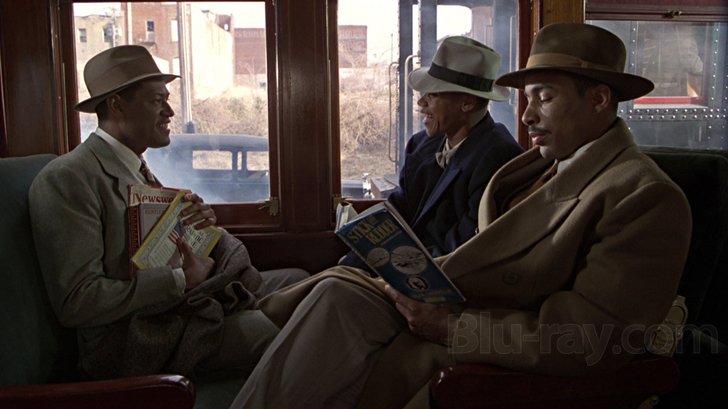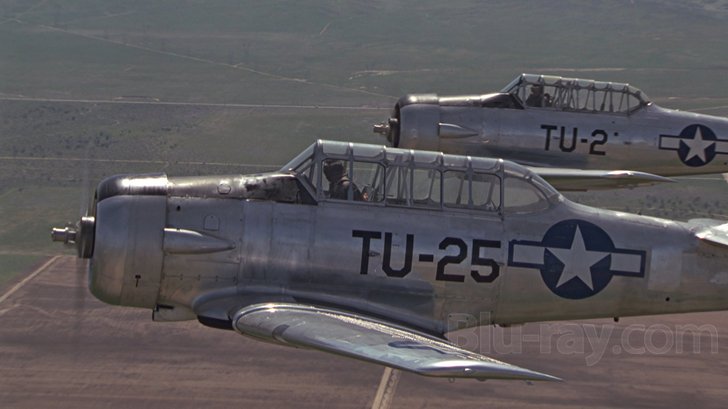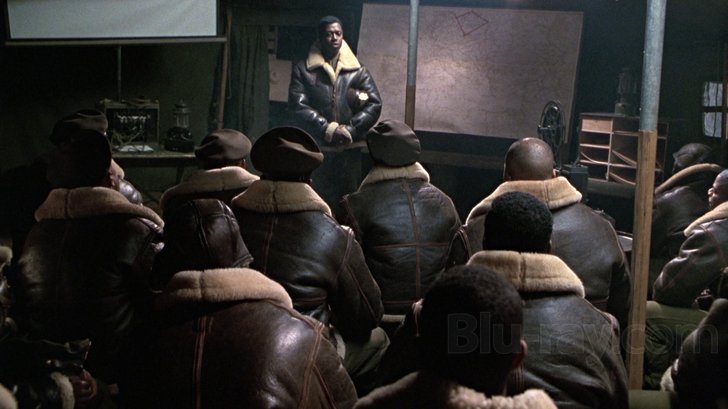The Tuskegee Airmen Blu-ray Movie
HomeThe Tuskegee Airmen Blu-ray Movie 
HBO | 1995 | 106 min | Rated PG-13 | Jan 17, 2012Movie rating
7.2 | / 10 |
Blu-ray rating
| Users | 3.8 | |
| Reviewer | 4.0 | |
| Overall | 3.8 |
Overview
The Tuskegee Airmen (1995)
The true story of how a group of African American pilots overcame racist opposition to become one of the finest US fighter groups in World War II.
Starring: Laurence Fishburne, Andre Braugher, Cuba Gooding Jr., Courtney B. Vance, Allan PayneDirector: Robert Markowitz
| War | Uncertain |
| History | Uncertain |
| Drama | Uncertain |
Specifications
Video
Video codec: MPEG-4 AVC
Video resolution: 1080p
Aspect ratio: 1.78:1
Original aspect ratio: 1.78:1
Audio
English: DTS-HD Master Audio 5.1 (48kHz, 24-bit)
French: DTS 2.0
Spanish: DTS 2.0 Mono
Subtitles
English SDH, French, Spanish
Discs
25GB Blu-ray Disc
Single disc (1 BD)
Playback
Region free
Review
Rating summary
| Movie | 4.0 | |
| Video | 4.5 | |
| Audio | 3.0 | |
| Extras | 2.0 | |
| Overall | 4.0 |
The Tuskegee Airmen Blu-ray Movie Review
Red Tails, First Version
Reviewed by Michael Reuben January 9, 2012Three days before the release of the Lucasfilm-produced Red Tails, HBO is issuing its ground-breaking version of the same story, The Tuskegee Airmen, on Blu-ray. The HBO original film first aired on the premium cable channel almost sixteen years ago and demonstrates, yet again, how slow Hollywood can be to embrace novel subjects. With the vast canon of World War II films, it's astonishing that over half a century elapsed before someone thought to make a major motion picture about the accomplishments of the first African-American combat pilots. HBO might not have had the budget that Lucasfilm gave Red Tails or the sophisticated effects provided by Industrial Light and Magic (judging from the trailer), but they did have a story co-written by Robert W. Williams, who was a Tuskegee Airman, and they assembled a great cast anchored by Laurence Fishburne, flipping 180 degrees from his Oscar-nominated role as Ike Turner in What's Love Got to Do with It? It's a square film, even a corny one, but some stories have earned the right to be square and corny. The saga of skilled, determined men repeatedly risking (and often sacrificing) their lives for a country where many fellow citizens despised them as subhuman and wanted them grounded is just such a story.

Most of the characters in The Tuskegee Airmen are fictionalized composites, including Fishburne's flyer, Hannibal "Iowa" Lee, who is the film's narrative anchor. We see Hannibal briefly as a kid (Christopher Bevins), playing with a model plane in an Iowa field and chasing after his father's crop-dusting plane with delight. Very quickly, though, it's 1942, and Hannibal, now a young man (Fishburne), is bidding his family farewell as he begins the long train ride for training in Alabama. En route Hannibal meets other trainees who will become his friends and who, in the time-honored tradition of military stories, provide a cross-section of personalities: Walter Peoples (Allan Payne), the intensely driven licensed pilot with an engineering degree and his head always buried in a copy of Stick and Rudder; Billy "Train" Roberts (Cuba Gooding, Jr.), the fast-talking Harlem kid whose constant stream of easygoing chatter is a disguise for the smart, ambitious guy underneath; Leroy Cappy (Malcolm-Jamal Warner), a decent, serious man, who, deep down, harbors doubts about himself; and Lewis Johns (Mekhi Phifer), a Southerner whose ready smile masks a deep cynicism about the country he's going off to serve. The film follows Hannibal and his compatriots from basic training to the eve of one of the Tuskegee Airmen's longest and most arduous missions, when, on March 24, 1945, their fighter planes escorted a squad of B-17 bombers from a base in Italy to Berlin and back. The production used vintage aircraft, vintage aerial footage and shots from previous movies (e.g., Memphis Belle) to create effective flying sequences on a tight budget. But the film's real drama occurs on the ground, as the trainees (and, eventually, army pilots) are almost daily reminded of the obstacles in their path. Their predicament is already there on the ride to Tuskegee. As soon as the train crosses into the Jim Crow South, Hannibal and his seat mates are hustled off the coach where they've been riding for the last thousand miles, because the car is now designated "Whites Only". As a final insult, German P.O.W.'s under guard are allowed to board the car from which these army enlistees are now barred. In their own country, they rank lower than the enemy. At Tuskegee, they're introduced to what their immediate superior, Lt. Glenn (Courtney B. Vance), describes as two different philosophies. One is represented by the base commander, Colonel Rogers (Daniel Hugh Kelly), who grasps that any man who has reached this point against such long odds must be both exceptionally talented and defiantly committed. The other is represented by the chief training officer, Major Joy (Christopher McDonald), who can't believe any black man could pass the written test required for a pilot without cheating and promptly re-administers it to every trainee. When no one scores below 95, the major argues that these valuable training slots could be filled by more "qualified" candidates, but Colonel Rogers shuts him down. On graduation day, when the major has to join the other officers in pinning wings on the first African-American pilots in the U.S. military, he looks ill. Even with exemplary performance, it takes something extra to push the military into letting the Tuskegee Airmen see active duty. The "something extra" is First Lady Eleanor Roosevelt (Rosemary Murphy), who arrives to tour the facility, then asks for a plane ride with Hannibal Lee. The incident is historically accurate, though the actual ride was with the chief flying instructor, Charles Anderson. But the specific identity of the pilot hardly matters. At that point in history, the impact of a news photograph showing the elderly First Lady with her familiar hat and pearls smiling confidently in the back seat of a plane being piloted by an African-American cannot be overstated. Not long after, the 99th (as it was then designated) was off to join the war in northern Africa. But even then, there were rumblings in Congress about ending the "experiment". The film provides a fictional Senator named Conyers (John Lithgow) as the spokesperson for the multiple voices of opposition, and the arguments deployed by Conyers are by no means unfamiliar. They would continue to be heard for decades after the war, though the language would gradually become more coded and politically correct. In the end, Conyers loses the argument, but only because the 99th's commanding officer, Colonel Benjamin O. Davis, Jr. (Andre Braugher), the only actual historical figure in the film besides Mrs. Roosevelt, shows up with his West Point bearing and a general supporting him to offer a defense of his men. (The historical reality was more complex, though dramatically less satisfying.) Meanwhile, the 99th continues to wrack up achievements, even as it suffers losses. "Friends die in our business", warned Major Joy during training, and there's a scene late in the film where Hannibal returns from a mission and looks silently around the base, remembering every friend he's known and lost. After the 99th is transferred to Italy, it's consolidated with newly arrived black squadrons from Tuskegee to form the 332nd fighter group, which is assigned to escort bombers. The group's track record for effectively fending off German attack planes is so impressive that they become the escort of choice. The film's climax comes when a racist Texas bomber pilot (Ned Vaughn), who refused to accept that "[fill in the expletive]" could be piloting those fighter planes, swallows his pride and stands up in a briefing to request the 332nd—because, when you're responsible for the lives of a bomber crew, you want the best protection there is. Just as there are no atheists in foxholes, there are no racists in the thick of aerial combat.
The Tuskegee Airmen Blu-ray Movie, Video Quality 

When HBO aired The Tuskegee Airmen in 1995, all of its broadcasts were 1.33:1. However, every DVD release of the film that I've been able to identify has been framed at 1.78:1. It appears, then, that even as early as the mid-Nineties, HBO was already anticipating eventual HD broadcasts of its original movies and/or possible theatrical distribution and was having its productions framed and protected for both ratios. As with another Blu-ray of a film from this period, Gia, the 1.78:1 framing does not appear to have been derived by lopping off significant picture information at top and bottom. Occasionally a shot may appear somewhat tightly framed (I have included a few examples in the screenshots), but not so much that I would judge the viewing experience to be compromised. The 1080p, AVC-encoded image for The Tuskegee Airmen is exceptional, given the vintage and budget of the project. The source material is in very good shape, and the image is clean and fine-grained. Detail on faces, uniforms and even the fur collars of the pilots' jackets is excellent. The color palette is broad and well-delineated, but just slightly faded to convey a period feel. Black levels are generally accurate, delivering true blacks in those rare nighttime scenes when they're called for. I saw no indication of high-frequency filtering, transfer-induced ringing or compression artifacts.
The Tuskegee Airmen Blu-ray Movie, Audio Quality 

HBO was not yet broadcasting in Dolby Digital when The Tuskegee Airmen first aired; DD itself was still relatively new to theaters. The original audio format was Dolby Surround, and the 5.1 mix presented on the Blu-ray in DTS lossless was probably created at a later date from the original tracks for the matrixed mix. There are a number of discrete rear channel effects involving planes and ground vehicles, though nothing like one would expect from a contemporary track produced from the ground up for 5.1 delivery. Dialogue is always clear (though that isn't much of a challenge when conveying enunciators like Andre Braugher and John Lithgow). The track's only disappointment is the orchestral score by Lee Holdridge (whose extensive credits include the cult classic The Beastmaster). The score should be grand, sweeping and stirring. Instead, it sounds thin, compressed and harsh at the high end—proof positive, for those who still need it, that lossless treatment doesn't necessarily mean better sound. The quality of the source material plays a much bigger role than the delivery format, and here the original recordings appear to be lacking in fidelity and dynamic range.
The Tuskegee Airmen Blu-ray Movie, Special Features and Extras 

- The sole extra isn't on the disc. It's the digibook packaging containing a "commemorative book" that artfully mixes black and white production photos from the film with archival photos of the real flyers from history. Included is a photograph of screen story co-author Robert W. Williams and a picture of the real First Lady Eleanor Roosevelt departing on the historic flight depicted in the film.
The Tuskegee Airmen Blu-ray Movie, Overall Score and Recommendation 

The exploits of what has come to be known as the Greatest Generation continue to fascinate viewers, as evidenced by the popularity of contemporary productions like Band of Brothers, The Pacific and Saving Private Ryan and the enduring interest in classics like Patton and The Longest Day. But while there is every reason to celebrate the Greatest Generation, it should also be remembered that, while they were fighting a war against the Axis powers, a small group of them had to wage a second war against powers at home who wanted to deny them the right to serve, citing the same spurious arguments ("shiftless", "lazy", "undisciplined", "unintelligent") that had been repeatedly refuted year after year, most recently at Tuskegee. When the war in Europe and the Pacific ended, the war on the homefront remained to be fought. The Greatest Generation entered World War II accompanied by a stain of wrongdoing that extended back to the founding of the republic (and beyond), and it does them no service to ignore either the stain or the extraordinary men who transcended it, achieving what many believed impossible to become some of the war's most decorated heroes. The film and the Blu-ray are highly recommended.
Similar titles
Similar titles you might also like

Generation War
Unsere Mütter, unsere Väter
2013

Emperor
2012

Glory 4K
1989

A Bridge Too Far
1977

The Dam Busters
1955

Anzio
1968

Land of Mine
Under Sandet
2015

The Longest Day
1962

Battle of Britain
1969

They Shall Not Grow Old
2018

The World Wars
2014

Into the White
2012

Battle of the Bulge
1965

Flags of Our Fathers
2-Disc Special Edition
2006

Overlord
1975

Downfall
Der Untergang | Collector's Edition
2004

Patton
1970

9th Company
9 rota | Collector's Edition
2005

Zulu
1964

Journey's End
2017

